
The Maginot Line, named after the French Minister of War André Maginot, is a line of concrete fortifications, obstacles and weapon installations built by France in the 1930s to deter invasion by Germany and force them to move around the fortifications. The Maginot Line was impervious to most forms of attack. In consequence, the Germans invaded through the Low Countries in 1940, passing it to the north. The line, which was supposed to be fully extended further towards the west to avoid such an occurrence, was finally scaled back in response to demands from Belgium, which feared it would be sacrificed in the event of another German invasion. The line has since become a metaphor for expensive efforts that offer a false sense of security.
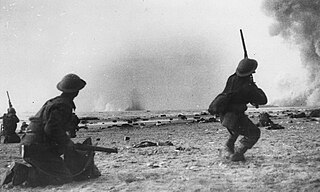
The Battle of Dunkirk was fought around the French port of Dunkirk (Dunkerque) during the Second World War, between the Allies and Nazi Germany. As the Allies were losing the Battle of France on the Western Front, the Battle of Dunkirk was the defence and evacuation of British and other Allied forces to Britain from 26 May to 4 June 1940.
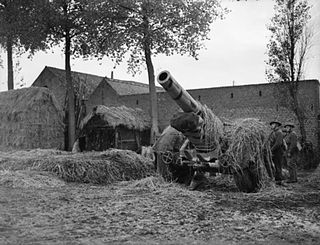
The Phoney War was an eight-month period at the start of World War II, during which there was only one limited military land operation on the Western Front, when French troops invaded Germany's Saar district. Nazi Germany carried out the Invasion of Poland on 1 September 1939; the Phoney period began with the declaration of war by the United Kingdom and France against Nazi Germany on 3 September 1939, after which little actual warfare occurred, and ended with the German invasion of France and the Low Countries on 10 May 1940. Although there was no large-scale military action by Britain and France, they did begin some economic warfare, especially with the naval blockade, and shut down German surface raiders. They created elaborate plans for numerous large-scale operations designed to cripple the German war effort. These included opening an Anglo-French front in the Balkans, invading Norway to seize control of Germany's main source of iron ore and a strike against the Soviet Union, to cut off its supply of oil to Germany. Only the Norway plan came to fruition, and by April 1940, it was too little, too late.

The Battle of France also known as the Western Campaign the French Campaign, and the Fall of France, was the German invasion of France, Belgium, Luxembourg and the Netherlands during the Second World War. On 3 September 1939, France had declared war on Germany, following the German invasion of Poland. In early September 1939, France began the limited Saar Offensive and by mid-October had withdrawn to their start lines. German armies invaded Belgium, Luxembourg and the Netherlands on 10 May 1940. Italy entered the war on 10 June and attempted an invasion of France. France and the Low Countries were conquered, ending land operations on the Western Front until the Normandy landings on 6 June 1944.
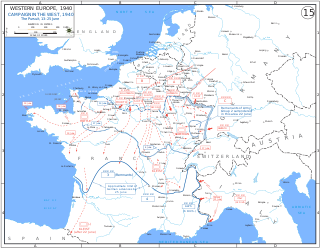
Fall Rot was the plan for a German military operation after the success of Fall Gelb, the Battle of France, an invasion of the Benelux countries and northern France. The Allied armies had been defeated and pushed back in the north to the Channel coast, which culminated in the Dunkirk evacuation. The operation to complete the conquest of France by the German Army began on 5 June 1940. Fall Rot began with a preliminary attack over the river Somme on the Channel Coast to the Seine, beginning on 5 June and the main offensive by Army Group A on 9 June further east over the river Aisne.

The Dunkirk evacuation, codenamed Operation Dynamo and also known as the Miracle of Dunkirk, or just Dunkirk, was the evacuation of Allied soldiers during World War II from the beaches and harbour of Dunkirk, in the north of France, between 26 May and 4 June 1940. The operation commenced after large numbers of Belgian, British, and French troops were cut off and surrounded by German troops during the six-week Battle of France. In a speech to the House of Commons, British Prime Minister Winston Churchill called this "a colossal military disaster", saying "the whole root and core and brain of the British Army" had been stranded at Dunkirk and seemed about to perish or be captured. In his "We shall fight on the beaches" speech on 4 June, he hailed their rescue as a "miracle of deliverance".
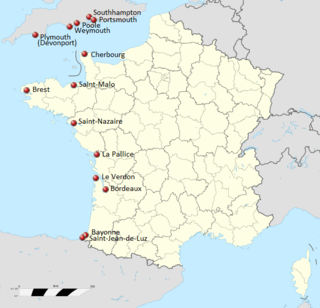
Operation Aerial was the evacuation of Allied forces and civilians from ports in western France from 15 to 25 June 1940 during the Second World War. The evacuation followed the Allied military collapse in the Battle of France against Nazi Germany. Operation Dynamo, the evacuation from Dunkirk and Operation Cycle, an embarkation from Le Havre, finished on 13 June. British and Allied ships were covered from French bases by five Royal Air Force (RAF) fighter squadrons and assisted by aircraft based in England, to lift British, Polish and Czech troops, civilians and equipment from Atlantic ports, particularly from St Nazaire and Nantes.

The Siegfried Line, known in German as the Westwall, was a German defensive line built during the 1930s opposite the French Maginot Line. It stretched more than 630 km (390 mi); from Kleve on the border with the Netherlands, along the western border of Nazi Germany, to the town of Weil am Rhein on the border to Switzerland – and featured more than 18,000 bunkers, tunnels and tank traps.

The 51st (Highland) Division was an infantry division of the British Army that fought on the Western Front in France during the First World War from 1915 to 1918. The division was raised in 1908, upon the creation of the Territorial Force, as the Highland Division and later 51st (Highland) Division from 1915. The division's insignia was a stylised 'HD' inside a red circle. Early doubts about the division's performance earned it the nickname of "Harper's Duds" after the name of its commander, Major-General George Harper.

Maurice Gustave Gamelin was an army general in the French Army. Gamelin is remembered for his disastrous command of the French military during the Battle of France in World War II and his steadfast defence of republican values.
The North West Europe campaign was a campaign by the British Commonwealth armed forces in North West Europe, including its skies and adjoining waters during World War II. The term Western Front has also sometimes been used informally. The United States military refers to this campaign as the European Theater of Operations.
The Timeline of the Battle of France, also known as the Fall of France, covers the period during World War II from the first military actions between Germany and France and to the armistice signed by France. Over the period of six weeks, from May 10 to June 25, 1940, Nazi Germany had also conquered Belgium, Netherlands and Luxembourg. Nazi Germany's overall plan was to invade the Low Countries which would make the French and British troops leave their current position and position their forces in Belgium. Then, a second force would navigate through the Ardennes Forest and move around the Maginot Line at the weakest part of the Allied defences. The force would then move towards the west French coast and cut the northern Allied force off. The Germans would then capture Paris, eliminate any resistance that remained, cross the English Channel, and invade the United Kingdom.
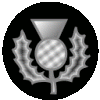
The 9th (Highland) Infantry Division was an infantry division of the British Army, formed just prior to the start of the Second World War. In March 1939, after the re-emergence of Germany as a significant military power and its occupation of Czechoslovakia, the British Army increased the number of divisions in the Territorial Army (TA) by duplicating existing units. The 9th (Highland) was formed in August 1939, as a second-line duplicate of the 51st (Highland) Infantry Division. The division's battalions were all raised in the Scottish Highlands.
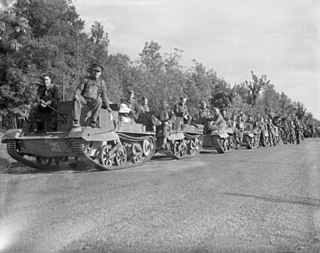
The British Expeditionary Force (BEF) was the name of the contingent of the British Army sent to France in 1939 after Britain and France declared war on Nazi Germany on 3 September, beginning the Second World War. The BEF existed from 2 September 1939 when the BEF GHQ was formed until 31 May 1940, when GHQ closed down and its troops reverted to the command of Home Forces. During the 1930s, the British government had planned to deter war by abolishing the Ten Year Rule and rearming from the very low level of readiness of the early 1930s. The bulk of the extra money went to the Royal Navy and the Royal Air Force but plans were made to re-equip a small number of Army and Territorial Army divisions for service overseas.

The Fortified Sector of Maubeuge was the French military organization that in 1940 controlled the section of the Maginot Line between the French border with Belgium and Maubeuge, a distance of about 70 kilometres (43 mi). The sector was not as strongly defended as other sections of the Maginot Line Large portions of the Maubeuge sector were defended by blockhouses or casemates. The sector includes only four ouvrages of the type found in stronger sections of the Line, arranged in an arc to the north and east of the fortified city of Maubeuge, incorporating defenses from the First World War. The Maubeuge sector and the Fortified Sector of the Escaut were the final sections of the Maginot line to be authorized, and were termed the "New Fronts." In the Battle of France the large fortifications of Maubeuge successfully resisted determined German bombardments and infantry attacks, despite their failure to protect Maubeuge against the Germans, who had outflanked the defensive line and who assaulted the fortification lines from the rear. Surrender or evacuation came only after the positions were surrounded and cut off from any hope of reinforcement. One ouvrage and one pre-Maginot fortification have been preserved.
The Fortified Sector of the Escaut, also known as the Fortified Sector of the Schelde, was the French military organization that in 1940 controlled the section of the Maginot Line between the French border with Belgium and Valenciennes, a distance of about 30 kilometres (19 mi). Named for the Escaut River, the Maginot line in the Escaut sector consists of a single position, the petit ouvrage Eth, together with its supporting casemate Jeanlain, as well as an upgraded fort of the Séré de Rivières system, the Fort de Maulde. The remainder of the sector's fortifications consist of blockhouses and casemates arranged along a line of principal resistance about 2 kilometres (1.2 mi) behind the frontier, with a second line on the edge of the Raismes Forest. The Escaut sector and the Fortified Sector of Maubeuge were the final sections of the Maginot line to be authorized, and were termed the "New Fronts." The Escaut sector was attacked during the Battle of France in late May 1940, resisting for a few days.
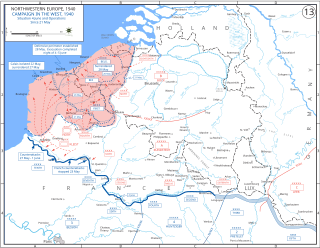
The Battle of Boulogne in 1940 was the defence of the port of Boulogne-sur-Mer by French, British and Belgian troops in the Battle of France during the Second World War. The battle was fought at the same time as the Siege of Calais, just before Operation Dynamo, the evacuation of the British Expeditionary Force (BEF) from Dunkirk. After the Franco-British counter-attack at the Battle of Arras on 21 May, German units were held ready to resist a resumption of the attack on 22 May. General der Panzertruppe (Lieutenant-General) Heinz Guderian, the commander of XIX Corps, protested that he wanted to rush north up the Channel coast to capture Boulogne, Calais and Dunkirk. An attack by part of XIX Corps was not ordered until 12:40 p.m. on 22 May, by which time the Allied troops at Boulogne had been reinforced from England by most of the 20th Guards Brigade.
The North Midland (Staffordshire) Heavy Battery was a Territorial Force (TF) unit of the Royal Garrison Artillery (RGA) formed in Staffordshire in 1908. It fought on the Western Front during World War I. Converted to medium artillery in the 1920s, the unit took part in the Battle of France and Dunkirk Evacuation in the early part of World War II, before returning to action in North Africa and Italy, and finally in North West Europe.
Gifford Folkard, known professionally as Harry Gifford, was an English songwriter. He worked from the 1900s but is best known for his work in the 1930s co-writing songs with Fred E. Cliffe for entertainer George Formby.

Operation David was the codename for the deployment of the British Expeditionary Force (BEF) into Belgium at the start of the Battle of Belgium during the Second World War. On the same day as the German invasion of neutral Belgium, 10 May 1940, the BEF moved forward from their prepared defences on the Franco-Belgian border to take up a new position deep inside Belgium, conforming to plans made by the French high command. Forming a defensive line with French and Belgian forces on either side, the BEF were able to contain attacks by German infantry divisions, but were unaware that this was a diversion; the main thrust by highly mobile German armoured divisions was further south. To avoid complete encirclement, the BEF and their allies were forced into a series of fighting retreats and ended up back at their initial border positions by 24 May. However, the German spearhead had reached the coast behind them, cutting them off from their supply chain and leading to the Dunkirk evacuation of the BEF in the following days.















